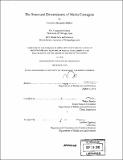The structural determinants of media contagion
Author(s)
Marlow, Cameron Alexander, 1977-
DownloadFull printable version (13.90Mb)
Other Contributors
Massachusetts Institute of Technology. Dept. of Architecture. Program In Media Arts and Sciences
Advisor
Walter Bender.
Terms of use
Metadata
Show full item recordAbstract
Informal exchanges between friends, family and acquaintances play a crucial role in the dissemination of news and opinion. These casual interactions are embedded in a network of communication that spans our society, allowing information to spread from any one person to another via some set of intermediary ties. Weblogs have recently emerged as a part of our media ecology and incidentally engender this process of media contagion; because weblog authors are tied by social networks of readership, contagious media events happen frequently, and in a form that is immediately measurable. The generally accepted notion of media diffusion is that it occurs through two channels: externally, as applied by a constant force such as the mass media, and internally through socio-structural means. Sitting between our traditional notions of mass media and the public, weblogs problematize this classical theory of mass media influence. This thesis aims to elucidate the role of weblogs in media contagion through a sociological study of this community in two parts: First, I will address the issues of modeling the social structure of weblogs as observed through their readership network, and the various media events that occur therein. (cont.) Using a large weblog corpus collected over a one-month period, I have constructed a model describing the structure of popularity and influence from the extracted readership network, and will show that this model more accurately describes the weblog network. I will also derive a typology of media events from collected examples using features of structural and non-structural diffusion. Second, the extent to which these data are reflective of actual social processes as opposed to artifacts of data collection and aggregation will be explored. To validate the models presented in part one, I have conducted a survey of randomly selected authors to examine their social behaviors, both in weblog use and otherwise. I will characterize the range of weblog uses and practices, presenting an analysis of personal influence in the blogging community.
Description
Thesis (Ph. D.)--Massachusetts Institute of Technology, School of Architecture and Planning, Program in Media Arts and Sciences, 2005. Includes bibliographical references (p. 157-166).
Date issued
2005Department
Program in Media Arts and Sciences (Massachusetts Institute of Technology)Publisher
Massachusetts Institute of Technology
Keywords
Architecture. Program In Media Arts and Sciences